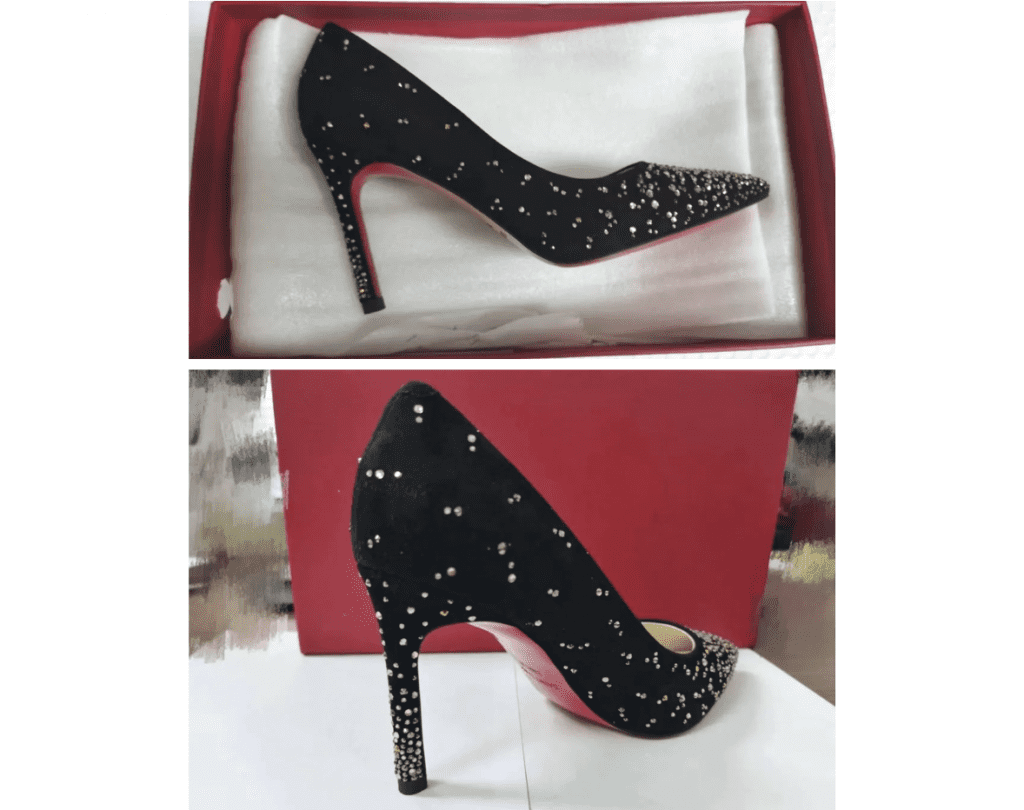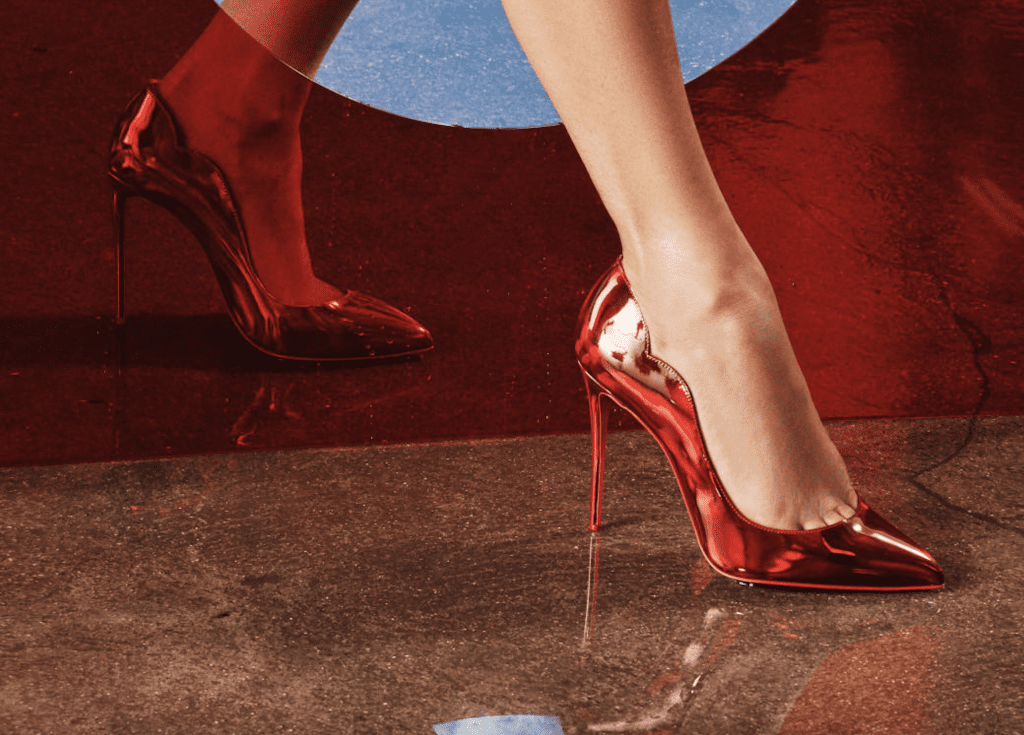A Chinese court has handed Christian Louboutin a win in battle over its red sole trademark. In a decision dated September 9, the Beijing Intellectual Property Court determined that defendant Guangdong Wanlima Industrial Co., Ltd. – a Shenzhen Stock Exchange-listed company in the business of designing, researching, production, manufacturing, and marketing leather products – ran afoul of China’s Anti-Unfair Competition Law by intentionally and “maliciously” offering up high-heel footwear bearing a red sole that mirrored the design and the well-known red sole of Louboutin’s shoes, thereby, giving rise to the chance that consumers will be confused as to the source of the shoes and/or their connection to Louboutin.
Setting the stage in its recently-released decision, the Beijing IP Court stated that Louboutin filed suit against Guangdong Wanlima Industrial Co., Ltd. (“Wanlima”), pointing primarily to the Guangzhou-based company’s sale of a variety of women’s shoes with “the same or similar trade names and red sole decoration” as its own red-soled stilettos by way of its official flagship store on Alibaba’s Tmall, as well as at New World Department Stores. The defendant’s sale of the lookalike footwear is particularly problematic in light of the “high reputation” of its red-soled shoes “in China and around the world,” Louboutin argued, alleging that its footwear – and its red sole trademark – is “well known to the relevant public,” and as a result, Wanlima had violated Article 6(1) of China’s Anti-Unfair Competition Law.
Article 6(1) of the Anti-Unfair Competition Law of China (2019 Amendment), which prohibits parties from offering up products that are confusingly similar to those of others, including by way of “a label [that is] identical or similar to the name, packaging or decoration … with certain influence.”
Siding with Louboutin, the Beijing IP Court held in a first-instance judgment that based on evidence submitted by the French brand, its red soled shoes and its red sole “decoration” amount to trademarks with “a certain influence.” Specifically, the court held that Louboutin submitted evidence showing that it has “actually sold footwear products in mainland China since 2011,” with a sales volume of more than RMB 900 million ($129.9 million) for its footwear, as well as evidence of third-party media coverage of its red-soled shoes from “many well-known media across [China], covering many parts of the country.”
This evidence was “sufficient to prove that [Louboutin’s] ‘red sole shoes’ product and red sole decoration have a high market reputation, have established solid connections with the relevant public, and have the distinctive feature of distinguishing the source of the product,” the court held. As a result, Louboutin’s “red soled shoes” trademark and the decoration with the sole color meet the “certain influence” bar set out by Article 6(1) of the Anti-Unfair Competition Law, according to the court, making Wanlima’s use of “the same or similar logos with the trade name of ‘red sole shoes’ and the decoration of red soles” a violation of the law.
With the foregoing in mind, the Beijing IP Court issued an injunction in Louboutin’s favor, requiring Wanlima to immediately and permanently cease its sales of red-soled footwear and to pay Louboutin damages to RMB 5 million ($721,855) and legal expenses of RMB 445,000 ($64,245).

Louboutin’s win follows from a 2020 victory when the Supreme People’s Court of China ruled in favor of the brand. Confirming a decision from Beijing Higher People’s Court, which overturned an earlier determination of the Chinese National Intellectual Property Administration, the Supreme People’s Court held that even though single color marks are among the types of marks that are listed as protectable under Article 8 of the Chinese Trademark (which explicitly lists “combinations of colors” as eligible for registration), Louboutin’s red sole still amounts to a protectable mark. In that case, Supreme People’s Court was swayed by Louboutin’s submission of evidence showing that its red sole had acquired distinctiveness in the minds of Chinese consumers.
As the Beijing Higher People’s Court determined – and the Supreme People’s Court subsequently affirmed, Louboutin’s use of a single color on the soles of its shoes “is not excluded by the law from being registered as a trademark,” as long as the consuming public has come to associate the red shoe sole with a single source, something that Louboutin can establish by showing that it has been using the mark on goods in China for a while, that it has advertised its mark there, and consumers have, in fact, come to associated the red sole with a single source (which can be established by way of consumer surveys).
The court’s decision in the earlier case “opened a door for business owners to pursue trademark registration protection of non-traditional trademarks with sufficient distinctiveness,” Steve Zhao and Pei Lyu of the Beijing-based AnJie Law Firm stated at the time.
The more recent outcome is the latest in a line of trademark and unfair competition cases (including one involving the shape of Chanel’s No. 5 fragrance bottle) that are resulting in wins for non-native brands, and thus, are proving to be beneficial not only for Louboutin but other brands, as well. Unfair competition cases, for one thing, are becoming “a valuable enforcement method for foreign companies to enforce intellectual property rights in China” – both when they have trademark registrations to point to (as Louboutin does) and also “when trademarks are unavailable, such as in the earlier New Balance/Barlun case,” according to Aaron Wininger, the director of Schwegman Lundberg & Woessner’s China Intellectual Property Practice.
As we noted in connection with the outcome in the Manolo Blahnik trademark case, which saw the Supreme People’s Court of China invalidate a China-based individual’s bad faith trademark registration targeting the famous footwear brand in July (a decision that is likely to pave the way for Blahnik to engage in a major expansion effort on the Chinese mainland), the Chinese National Intellectual Property Administration and Chinese courts at various levels, alike, are increasingly dealing wins for non-native brands that have become especially well known in other markets.
The result is likely to be increased confidence and investment in the Chinese market by Western brands, particularly as China continues to be a hot bed for luxury goods sales (even if it is currently being plagued by the impact of COVID lockdowns). Sales of personal luxury goods in mainland China grew by 36 percent year-over-year in 2021 to 471 billion yuan ($73.6 billion), keeping the country on track to nab the title of the world’s largest luxury goods market by 2025. Mainland China’s share of the global luxury market was up about 21 percent last year, according to Bain, whose analysts said early this year that they anticipate such growth to continue.











